Happy PR Friday. Post PRs or updates to comments
The Romanian Deadlift (RDL) is a quality exercise that can be used to strengthen the lumbar erectors, gluteals, and hamstrings — but primarily the hamstrings. The lift was introduced to the U.S. when Romanian weightlifter Nicu Vlad (coached by Dragomir Cioroslan) was doing them while training the OTC. Vlad has the heaviest double body weight snatch ever; he snatched 200kg while weighing 100kg. In any case, the RDL was adopted by weightlifters, strength trainees, bodybuilders, etc.
The RDL is often butchered by many lifters and trainees. The point of this exercise is to stretch the hamstrings, incorporate a slight stretch reflex out of the bottom, and extend the hips primarily with the hamstrings. The most often error is flexing (bending) the knees too much. Flexing the knees closes the knee angle and contracts the hamstrings a little bit. If the hamstrings are contracted slightly, then they can’t be stretched out appropriately for the efficacy of the lift. In movements like the RDL and Good Morning, the purpose isn’t to load weight on the bar and measure your dick. Instead, they should be done correctly as to work the muscle.
How To Do It
Assume a hip-width deadlift stance. Some inexperienced trainees deadlift with wider stances and aren’t going to properly train their structures. It may be that their structures haven’t been developed to do it correctly, so they use a wider stance because it allows them to lift more weight. This is like taking vitamin C to treat a cold; it merely treats the symptoms. The RDL can help develop musculature for the deadlift.
The grip will be right outside of the legs and hips — not narrow enough so that the knuckles of the thumb drag on the thighs, but not much wider. The RDL stops in the “hang position”, or the same position of a locked-out deadlift. From this standing position, the knees are merely UN-LOCKED as the hips are pushed back. It’s imperative that the knees don’t flex more than this UN-LOCKED position since knee flexion will reduce the stretch on the hamstrings. More weight can be lifted when the knees are flexed more, but that doesn’t make it right. Just because you can doesn’t mean you should.
Pus the hips back with UN-LOCKED knees. The upper and lower back will remain in extension (but not hyper-extension — females take note) while the hips are pushed back. The lifter can imagine pushing their butt back towards the wall behind them. The knees should NOT travel forward at all. If the knees have traveled forward, then they have flexed. Keeping the shins vertical accounts for not allowing them to travel forward.
The next important point is to keep the bar back into the legs. If the bar flops forward, then it throws off the mid-foot balance, ruins the efficacy of the lift, and the extensors of the shoulders don’t get any work.
Now look at the picture of Vlad doing them above. Notice how he has some extra knee flexion? Don’t do this. He appears to be aiming for a greater stretch in his hamstrings and is even standing on a block to do it. Instead, emulate the following picture.
The only thing wrong with this guy is that the third picture isn’t the bottom of the RDL. The angle of the back will be right at, or possibly above parallel. The weight will NOT touch the floor; it will reduce the tension on the hamstrings as well as the stretch reflex. However, that guy is doing a good job of un-locking his knees and not letting them go forward while he pushes his hips back to lower the weight. Another way to think of it is that the knees are slightly flexed but don’t flex anymore while the hip flexes.
Points of Emphasis
1. Start in the hang
2. Un-lock knees
3. Push hips back
4. Don’t let knees go forward
5. Keep the bar back
6. Once the back angle is arbitrarily parallel, or the hamstrings are sufficiently stretched (you’ll know), reverse the movement
7. Drive the heels through the ground
8. Continue to keep the bar back and not let the knees go forward
9. Return to the hang position
Let’s look at some common faults.
1. This picture is what most people look like while doing RDLs, and it’s dead wrong. It looks like this dude has 295 lbs. on the bar when he may not be able to do 185 correctly. There is no lumbar extension, his hips haven’t been pushed back, the bar has gotten away from him, and he’s using an alternated grip. The RDL is an assistance exercise and should be trained with symmetry. If you can’t hang onto the weight throughout the course of the set, then use straps with a double overhand grip. This is all kinds of wrong.
2. This guys isn’t terrible, but he has allowed his knees to flex too much. Now he has just turned it into some kind of light weight deadlift. If you think about it as merely UN-LOCKING the knees, then you aren’t incorrectly allowing them to flex any more. Knees back, hips back.
3. This girl has done a good job of not letting the knees flex and pushing the hips back, yet she has a rounded lumbar/sacral junction. It is very possible that she has an overly long sacrum and short back, but that would require her not going as low since she has broken away from a straight torso. Make sure that the thoracic/lumbar and lumbar/sacral junctions are straight — and not hyperextended or flexed — during lifting. Another noteworthy point with this girl is that she’s looking up. Her cervical spine is extended, and having the cervical spine anything other than neutral during lifting is not preferable. Most people won’t get hurt, yet keeping a neutral spine during lifting is preferable than awkwardly extending it up (and I would say the same thing for squatting).
I’ve been meaning to take some pictures and video of the RDL, but hopefully by looking at some random internet pictures you can get an idea of what constitutes a good and bad RDL.
The Important Cues
1. Un-lock the knees
2. But don’t let them go forward
3. Push hips BACK
When To Do Them
RDLs are a great assistance exercise for deadlifts and can even be used in lieu of deadlifts in older trainees, very weak trainees, or females. It’s no great secret that a lot of figure competitors use RDLs to build wonderful backsides, so the prospect of incorporating them with squats may appeal to the gal who is weary of lifting in general.
I like having high-bar squatters RDL on a regular basis. The high/low bar bickering may be boring or entertaining, yet the two movements develop hip musculature differently. By adding in RDL’s in a high-bar program, they can help develop the strength and musculature of the hamstrings.
For a regular strength trainee, I would have them do the RDL’s in the opposite end of the week from deadlifts. If you deadlift on Fridays in a LP or TM set up, then do RDL’s on Monday or Tuesday (the Assistance Day for the TM). If you are running the Greyskull LP, then you could do them on Friday.
If the RDL is used correctly, it can help out a lot. I suggest starting with 135 for 8 to 10 reps. Assuming you haven’t been doing them, you’ll probably be sore. Increase the weight each workout and decrease the reps until you’re doing it for 3×5 and progressing it like a strength lift. Take your time getting to 225 lbs for three sets of five. That’s normally where my work sets are and I’ve done it with 110kg before. If you’re getting beyond 275 and you don’t weigh over 230, then you’re probably doing them wrong. I’ve seen various sub 200 pound friends doing them with around 300, and they weren’t getting the full benefit. Gutting through RDLs with a round back and knee flexion isn’t doing RDL’s, it’s doing shitty deadlifts. Use this to train the lumbar extensors to maintain their position while the hamstrings eccentrically and concentrically work. It’s what is supposed to be happening in a deadlift anyway, and unless you’re a powerlifter it’s how deadlifts should primarily be done anyway.

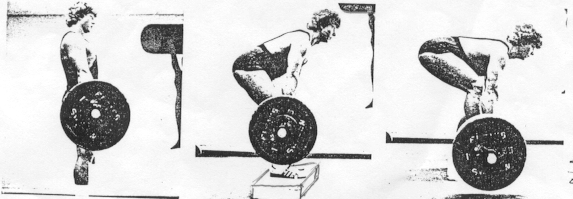
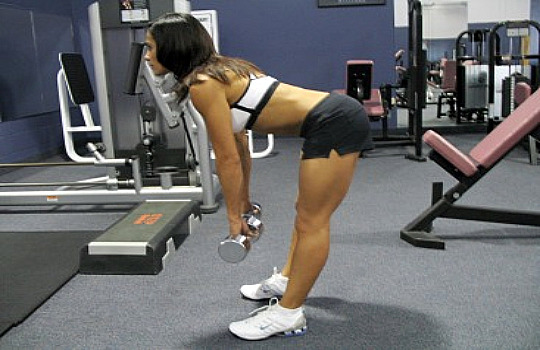

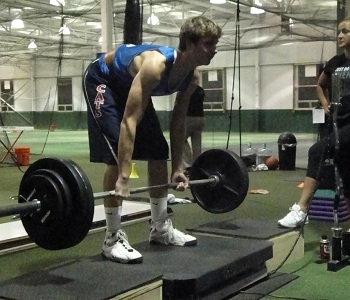
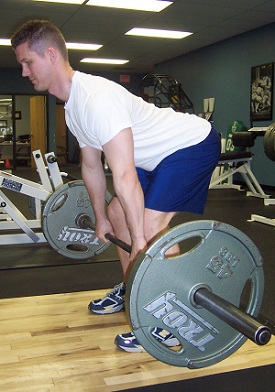
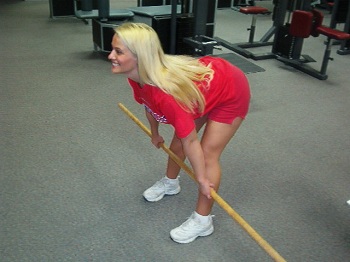
Thank you for another wonderfully informative post. I’d been wondering about RDLs for quite some time and this helps clear up my confusion on overall leg position, particularly on the knee lock-out thing.
PRs: Hit 275x5x3 last night having worked on my squat form with AC’s excellent suggestions for the last week and a half. Will video and post next week. Hit 105×5 on military press but I think I have some form work to do on this as well. Form correction on Pendlay rows continues and I’m making good progress. I also signed up for an Olympic lifting workshop at the local CrossFit gym that runs for four weeks and ends in a meet. Woo.
Any major advantage/disadvantge using GM vs. RDL’s, seems like similar poistions throughout the movement just the difference in leverage would account for the weight being used? Thanks.
PR: Power Jerk, 145kg x 1
Squat: 425# x 3
I’d rather someone do RDLs over Good Mornings. More weight can be handled correctly and it’s easier to do, and hypothetically safer. Unless someone is pretty experienced with all kinds of lifting, I’d rather them do RDL’s.
–Justin
PR set of 5 on Deadlift for 345
Jacked up my back though, my last rep was bad and I’m hurting this morning. I think its a lumbar strain. Eff!!! no deadlifts for a couple weeks. piss! any advice would be helpful.
What happened? How long have you been lifting? I prefer to shift people into triples instead of fives.
–Justin
Is this a proper RDL? :-D
http://oi52.tinypic.com/2uglawx.jpg
Anyway. I contacted a crossfit gym nearby and asked them if they’d let me lift there and do programming that was somewhat separate from their classes and they said they’d get back to me; not sure what’s so fucking difficult, it’s kind of a yes or no question. I’d like to get into olympic lifting but the only place that has the equipment nearby me is this crossfit gym, as far as I know. CT fucking blows.
I belted out this post pretty quickly, and when I left to go train, I realized that I had pictures of Shana of doing the RDL. I’ll probably make a .gif, but yes, that’s a correct bottom position.
–Justin
Deadlift 445×3 ez
Bench 330×3 ez
Doing the fucking bulldance!
PRs:
Squat 185 kg (~408 lbs) x3
Bench 122 kg (~269 lbs) x3
Deadlift 207,5 kg (~457 lbs) x3
The last rep on every one of these was so fucking hard that I almost missed it…
Great description of an interesting exercise that I had written off before. I will have to consider putting these in as assistance in my new routine.
No PRs yet, tonight should be some big milestones though.
Justin is a mind reader. I was just thinking of asking you to address RDL’s. Your timing is impeccable.
do RDL’s and goodmornings emphasize the same muscles?
For the most part. Good mornings are typically butchered much worse than RDLs. The upper back musculature involvement will be different since GMs require the thoracic muscles to hold the bar in place, especially when the torso is parallel. I’d rather a lifter do RDLs — they also help train the shoulder extensors to keep the bar back when pulling, which is necessary for deadlifting.
–Justin
Who measures their dick with RDLs? I measure mine with tape measure!
It sounds silly (ego lifting with RDLs), but it happens all the time with any exercise.
–Justin
Preparedness PR:
1 Month beard and Wolf shirt that says “IRRESPONSIBLE” on the back along the collar for my meet in 2 days.
Take pictures.
–Justin
djay – where are you in CT? Gary Valentine in Wilton, CT (www.connecticutweightlifting.com) and his lifters lift hard. I’m in Cheshire and the CF gym there let me lift whever I want.
Eric, thanks for the heads up; I’ve heard of Gary Valentine and looked his gym up a while ago but it’s well over an hour away from me, which is a bit of a commute. I’m in Guilford. Hopefully this CF gym is as obliging as yours!
Starting the 5/3/1 for PLing on monday. Have been getting pretty burntout from summer classes/work to the point that progression has pretty much stopped at a 240lbsx5 squat. Once the above mentioned stuff is over, back on an LP.
RDLs do make for a nice backside.
Justin,
I’d include that the knees should remain unlocked at the top, with the lifter never really fully “locking out” like you would a deadlift, but instead keeping the shoulders over the bar (or at least this is how I have been taught by oly coaches).
The idea here would be to maintain tension on the hamstrings even at the top. As of now (while considering the mechanics and motor pathway), I’d rather someone return to full hip extension at the top so that the hip goes through a full range of motion. Having a funky, arbitrary point to return to at the top will not be easy for many people and will probably exacerbate the knee flexion when they are tired. Furthermore, the top position is the same as a locked-out deadlift (many people erroneously lean backwards on their deadlifts), so ingraining the position AND going through a full ROM is preferable.
–Justin
Squat 295x3x5
Bench 255x1x4 It went downhill from there
Deadlift 395x1x5
Press 160x3x5
All this talk of lifting has made me hungry. Good bye.
BTW bodyweight is being very stubborn at 180. I need to start putting a lot more effort into eating. I don’t know about this JM Blakely diet though.
Read the JM Blakely story and you’ll see it’s for hardcore bulking, usually with steroids. Don’t erroneously apply it.
–Justin
Long time since post. Been working hard and hit a couple PR’s in the last two weeks.
Presses: 245X1 last week
Deadlifts: 535 X2 X3 Wednesday this week
I am guilty of doing RDL’s like #1 but its good to have this article to help with making the proper corrections. Thanks Justin.
Hey kittensmash how bout you suck justins dick some more. Douche.
U mad?
Stankrom, be nice to my internet friends. Also, your trolling could be better.
I’ll e-mail your pussy little e-mail so you have my address.
–Justin
Doogie,
I presume you are using the very same tape measure that was purchased for our ASSessments to measure your schlong. Good to know. I will keep this in mind when it comes time for my follow-up measurements.
Everyone is talking about RDLs
http://startingstrength.com/resources/forum/showthread.php?t=24248
Justin, Just took some of the shirt. There will be a video of the meet.
does not compute
Power Clean: 82.5 kg (181.5lbs) 5×3
Squat: 190 kg (418lbs) 3×1
Bench Press: 142.5 kg (313.5lbs) 3×1
justin, this:
http://2.bp.blogspot.com/_MbGZvHRzvFU/TS0Ksdww4qI/AAAAAAAAKb4/9x8IVJjDQzs/s1600/15-Dmitriy-Klokov-getty.jpg
Squat: 300 pounds x 1.
My full squat is only about 20 pounds behind my parallel squat. Is this normal or does it mean I’m genetically superior and will soon snatch 600 pounds? Just curious.
Hey Justin, what do you think about what OTHER Justin has to say about RDLs and not worrying all that much about the knee? I know he says stiff legged deadlifts but his legs aren’t stiff and his back is arched.
Hey Penn,
A stiff-legged deadlift would be a deadlift done with the stiff-legged form — the bar is at a dead stop on the ground and the lift is performed and returned to the ground. This is where the RDL differs, since it starts at the top and is a stretch reflex without being put on the ground at the bottom. In any case, he’s doing what I would refer to as RDL’s. He also has a crazy long back. But I’m splitting hairs, so let’s get to the knee thing.
He and I are essentially saying the same thing at the knee, and that’s solidified by his demonstration. It’s more about keeping the lumbars extended and pushing the hips back (as he does in his vid). I can make an amendment to my post if I didn’t clarify well enough, but when the lumbar is extended, that has a bit of anterior rotation in the hips. Since the hamstrings proximally attach at the ischial tuberosity on the rear of the pelvis, if that pelvis is anteriorily rotated, it will pull that proximal attachment up (since the rear of the pelvis is elevated with anterior rotation). Assuming no change at the knee, anterior pelvic rotation will stretch the hamstrings a little. It’s imperative to have the back extended because it ensures that the hamstring is going to get stretched to the maximum length it can be.
Concerning the knee. If the knees are locked out, then this places the emphasis of the stress (because of the body’s leverage) at the very distal hamstring area right at and slightly above the knee (on the posterior side, obviously). By unlocking the knee but NOT flexing them beyond a slight flex, the emphasis of musculature involves shifts to the middle and proximal hamstring.
In any case, Mr. Justin Harris is making an emphasis on the extension of the back for RDLs to be effective. The above explanation details why lumbar extension and slight knee flexion are important. Harris talks about it in more of a macro or conceptual manner, but we are saying the same thing.
Dude is big, too.
–Justin
Bench 210# 3×5
:|
Press 81kgx3x5
Curl 155×5
Dip 75×12
Haven’t done today’s workout yet.
Squat is up to 245X5 and progressing weekly. Deadlift is also up to 335X5. Still moving in 10# jumps/week, so hopefully I can keep that up for a while!
Bench and press have stalled the past two weeks. Hope to push past that this next week.
Justin,
I’ve been lifting for about a year now. What happened on the deadlift was, my first four reps were fine, but on the fifth my hamstrings got lazy and i raised them a little too fast and th elast few inches of my lift were all lower back. Result = muscle pain in lower back. I stretched it but it was pretty sensitive. This morning I continued stretching it and putting on icyhot. Around lunchtime the pain went away and now I just have regular soreness. So I’m hoping it wasn’t anything serious. I would like not to have to skip on deads or squats for a long time.
thanks for covering RDLs, justin! haven’t lifted yet today, but this is my second friday on a TM…so perhaps some PRs are coming. still tweaking the volume/intensity/scheduling. i think we’re getting closer to ideal under the circumstances…
you want a piece of me boy?
go go go!
you gonna give me orders?
this better be good.
SCV ready.
what’s going on?
great job, huh?
armed and ready!
we hear ya!
in the rear with the gear.
been waiting on you.
yeah, yeah. whatever.
who wants some?
don’t leave me hangin.
we could use some help here.
this better be good.
sure thing.
it’s go time.
die die die!
why not?
kaboom, baby!
Awww, lil’ Stank is so cute with his insults. Am I being too gay for you by calling you cute? I certainly hope so.
It’s about to get heavy!
squat – 5 x 3 280 lbs
bench – 5 X 3 220 lbs
deadlift – 5 X 3 305 lbs
as always i still suck but i suck a little less than last week.
thunderthighs. you rule for quoting starcraft. Way to be madam.
“Did somebody call for an exterminator?”
GSLP PR’s
Squat: 140kg x10
Deadlift: 180kg x6
Press: 70kg x8
Bench: 119kg x7
Weighted chins: 34kg x8
Pingback: Saturday, June 11, 2011 | CrossFit Toronto
I’m having a great pressing PR run…
Bench 267 lbs 2×5+6
Press 172 lbs 3×5
Squats and Deads headed for PR territory in a couple of weeks.
On third week of beach volleyball Tuesdays right between Mond squats and Wedn deads…requiring some serious adaptation.
Stankrom,
Please learn to punctuate and capitalize when typing, you sad example of public education.
(I can’t believe that did not bother me the first time I read it.)
1.how much knee flexion is acceptable for good mornings?
2.does snatch grip RDL’s focus more on the low back?
Squat: 365x3x5
Bench: 212.5×5 (easy)
370 monday on squats rawr!
I FINALLY GOT A SET OF 3 STRICT PULL UPS BITCHES
I ALSO BENCHED 100 LBS! i hit PRs at 96, 97, and 98. my previous best has been 95 since last summer. i know this sounds insignificant, but i struggle with that damn benching contraption. my arms are beyond long. they are looooong (i know some of you have seen them and know what i’m talking about)
squat and press didn’t budge this week. squat has not seen an absolute PR in a couple months. press i think was just tired.
never know what hit ’em.
@simonsky: snatch grip will use the lats and upper back differently and be harder to grip, but should be about the same for everything else.
PRs:
445 squat, 40 off best, but it’s 2.5 bw and was deep and easy. +10 from last friday.
Bench 295x1x4
The first rep was too heavy to do 5 times, so I took the 35’s off and put a 25 and 10 on each side and did 3 more sets before I realized I hadn’t changed the weight…
PR’s:
dealoaded the squat to 112.5kg and using greyskull lp – got 10 reps on the last set easily
Deadlift: 3@155kg
Weigh 78kg at 183 cm. need to weigh more. perhaps around 90kg? i’m not sure